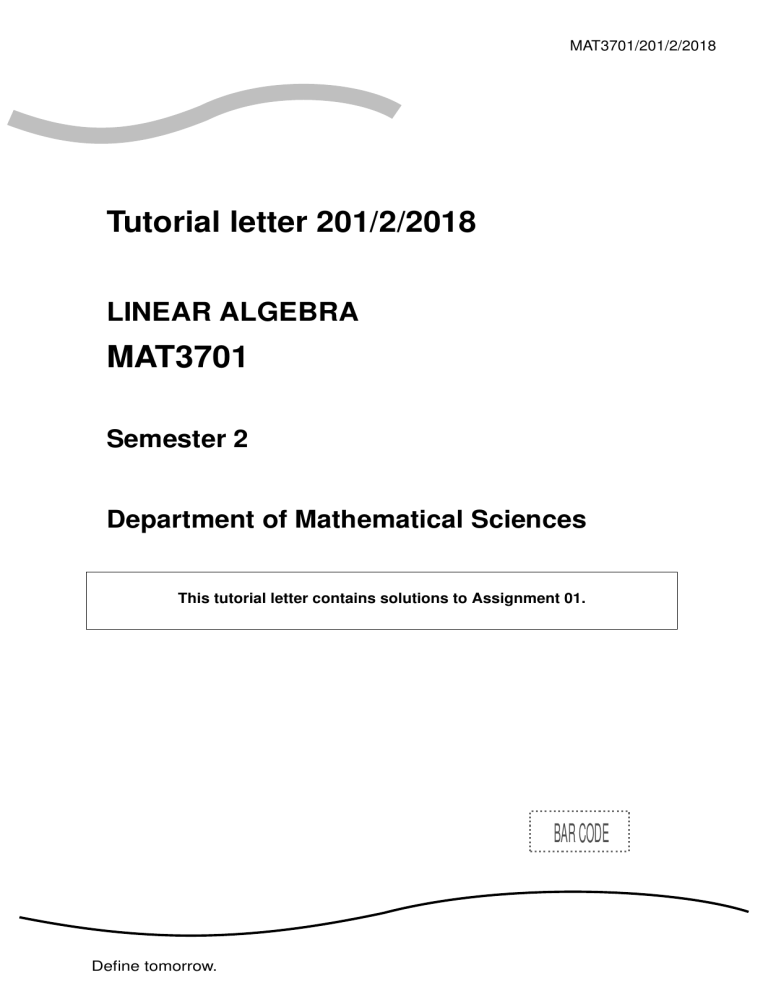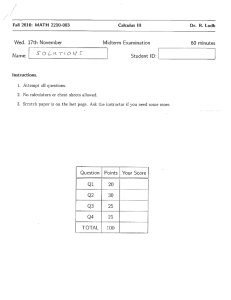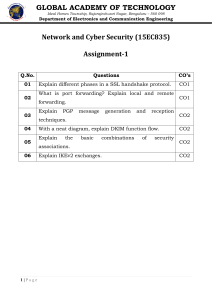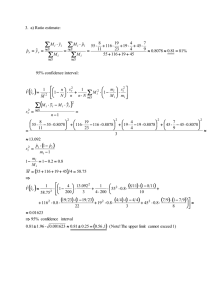
MAT3701/201/2/2018
Tutorial letter 201/2/2018
LINEAR ALGEBRA
MAT3701
Semester 2
Department of Mathematical Sciences
This tutorial letter contains solutions to Assignment 01.
BAR CODE
Define tomorrow.
ASSIGNMENT 01
Solution
UNIQUE ASSIGNMENT NUMBER: 868142
Please note that we will only mark a selection of the questions. It is therefore in your own best interest
to do all the questions. The fact that a question is not marked does not mean that it is less important
than one that is marked. We try to cover the whole syllabus over the two semesters (4 assignments)
and to use these assignments to help you prepare for the exam. It is therefore good practice to work
through a complete set of four assignments for a given year, and for this reason the assignments and
worked solutions of previous years are posted on myUnisa under Additional Resources – see also the
letter MAT3701 Exam Preparation under Additional Resources.
Worked solutions to all the questions will be posted on myUnisa shortly after the due date. Your
answers to the assignment questions must be fully motivated.
For this assignment, questions 2, 3, 5 and 6 will be marked.
Question 1
This question was not marked.
It is still important to work through the solutions and compare them with your own attempts.
Let A =
1 −1
2 −1
and B =
i 0
0 −i
, and let
W1 = {X ∈ M2×2 (C) : AX = XB}
and
W2 = {X ∈ M2×2 (C) : AX = iX} .
(a) Show that W1 is a subspace of M2×2 (C) .
(b) Given that W2 is a subspace of M2×2 (C) , find a basis for W1 ∩ W2 .
(c) Explain whether M2×2 (C) = W1 ⊕ W2 .
Solution
(a) ST1: W1 6= φ, since e.g. 02×2 ∈ W1 .
ST2: Suppose X1 ∈ W1 and X2 ∈ W1 . Then
A (X1 + X2 ) =
=
=
Thus X1 + X2 ∈
2
AX1 + AX2
X1 B + X2 B since X1 , X2 ∈ W1
(X1 + X2 ) B.
W1 .
MAT3701/201/2/2018
ST3: Suppose z ∈ C and X ∈ W1 . Then
A (zX) =
=
=
Thus zX ∈
z (AX)
z (XB) since X ∈ W1
(zX) B.
W1 .
Since all three conditions are satisfied, W1 is a subspace of M2×2 (C) .
(b) Let X = [X1
X2 ] where X1 and X2 denote the first and second columns of X respectively.
Then
X ∈ W1 ∩ W2
Let X1 =
x1
x2
⇔ AX = XB and AX = iX
i 0
⇔ A [X1 X2 ] = [X1 X2 ]
and A [X1 X2 ] = i [X1 X2 ]
0 −i
⇔ [AX1 AX2 ] = [iX1 − iX2 ] and [AX1 AX2 ] = [iX1 iX2 ]
⇔ AX1 = iX1 and AX2 = −iX2 = iX2
⇔ AX1 = iX1 and X2 = 0.
...(i)
, then
1 −1
x1
x1
⇔
=i
2 −1
x2
x2
⇔ x1 − x2 = ix1 and 2x1 − x2 = ix2
⇔ x2 = (1 − i)x1 .
AX1 = iX1
Thus
X1 =
x1
(1 − i)x1
so
1
0
1−i 0
1
0
1−i 0
= x1
and therefore
X = [X1
1
1−i
X 2 ] = x1
,
x1 ∈ C
,
x1 ∈ C
is a basis for W1 ∩ W2 .
(c) No, since W1 ∩ W2 6= {0} .
Question 2
Let fa , fb and fc be the Lagrange polinomials associated with the distinct real numbers a, b and c
respectively. Define T : P2 (R) → P2 (R) by T (g) = g − g (a) fa .
(a) Show that T is a linear operator.
(b) Explain whether T is a projection.
(10)
(5)
3
(c) Find [T ]β where β = {fa , fb , fc }.
(5)
[20]
Solution
(a) Let g, h ∈ P2 (R) and d ∈ R.
Then
T (g + h) =
=
=
=
g + h − (g + h) (a) fa
g + h − (g (a) + h (a)) fa
g − g (a) fa + h − h (a) fa
T (g) + T (h)
and
dg − (dg) (a) fa
dg − dg (a) fa
d(g − g (a) fa )
dT (g) .
T (dg) =
=
=
=
Thus T is a linear operator.
(b) T 2 (g) = T (g − g (a) fa )
= T (g) − g (a) T (fa )
= g − g(a)fa − g (a) (fa − fa (a)fa )
= g − g(a)fa − g (a) (fa − fa ) since fa (a) = 1
= g − g(a)fa
= T (g) .
Thus T is a projection.
(c) T (fa ) = fa − fa (a) fa = 0 since fa (a) = 1
T (fb ) = fb − fb (a) fa = fb since fb (a) = 0
T (fc ) = fc − fc (a) fa = fc since fc (a) = 0
Thus
0 0 0
[T ]β = 0 1 0 .
0 0 1
Question 3
Let T : V → V be a linear operator on a vector space V over F.
(a) Show that T 2 = I ⇔ R (T + I) ⊆ N (T − I).
4
(10)
MAT3701/201/2/2018
(b) Suppose
span
that
V
1
1
,
0
0
4
= R
and F = R. Find a formula for T such that T 2 = I, R (T + I) =
0
0
and N (T + I) = R(T + I)⊥ .
(20)
1
0
[30]
Solution
(a)
T 2 = I ⇔ (T 2 − I)(v) = 0 for all v ∈ V
⇔ (T − I)(T + I)(v) = 0 for all v ∈ V
⇔ (T + I)(v) ∈ N (T − I) for all v ∈ V
⇔ R (T + I) ⊆ N (T − I) .
(b)
x1
x1
1
x1
0
x
x
1
x
0
2
2
2
: · = · =0
N (T + I) =
x3 x3 0 x3 1
x4
x4
0
x4
0
x
1
x
2
= : x1 + x2 = x3 = 0
x3
x4
x1
−x
1
: x1 , x4 ∈ R
=
0
x4
1
0
−1 0
= span , .
0
0
0
1
Since
V = R(T + I) ⊕ R(T + I)⊥ = R(T + I) ⊕ N (T + I)
it follows that
1
0
1
, 0
β=
0 1
0
0
is a basis for V. Since according to (a), T (v)
v ∈ N (T + I), it follows that
1
1
0
0
1 1
0 0
T
0 = 0 , T 1 = 1 and
0
0
0
0
1
0
−1 0
,
,
0 0
0
1
= v for all v ∈ R(T + I), and T (v) = −v for all
1
−1
−1 1
T =
0 = 0
0
0
,
0
0
0 0
T
0 = 0
1
−1
.
5
Now
1
1
1
0
0 1 1 1 −1 1
T
0 = 2 T 0 + 2 T 0 = 0
0
0
0
0
0
1
1
1
1 1 1 1 −1 0
T
0 = 2 T 0 − 2 T 0 = 0
0
0
0
0
0
0
0
0
0 0
0 0
T
1 = 1 and T 0 = 0 .
0
0
1
−1
So
a
1
0
0
b
= aT 0 + bT 1 + cT 0 + dT
T
c
0
0
1
d
0
0
0
0
1
0
0
1
0
0
0
= a
0 + b 0 + c 1 + d 0
0
0
0
−1
b
a
=
c .
−d
0
0
0
1
Question 4
This question was not marked.
It is still important to work through the solutions and compare them with your own attempts.
Let T : M2×2 (C) → M2×2 (C) be the linear operator defined by
a b
a
b−c
T
=
c d
−b + c d
(a) Show that T satisfies the test for diagonalizability.
(b) Find a basis τ for M2×2 (C) consisting of eigenvectors of T and write down [T ]τ .
6
MAT3701/201/2/2018
(c) Show that T satisfies the equation (T − I)3 = T − I.
Solution
(a) Let
β=
E11
1 0
0 1
0 0
0 0
=
; E12 =
; E21 =
; E22 =
.
0 0
0 0
1 0
0 1
Then
T
T
T
T
1 0
(E11 ) =
= E11
0 0
0 1
(E12 ) =
= E12 − E21
−1 0
0 −1
(E21 ) =
= −E12 + E21
1 0
0 0
(E22 ) =
= E22 .
0 1
Therefore
1 0
0 0
0 1 −1 0
[T ]β =
0 −1 1 0 .
0 0
0 1
· · · (i)
Now
det λI4 − [T ]β
λ−1
0
0
0
0
λ−1
1
0
=
= (λ − 1)2 (λ − 1)2 − 1
0
1
λ−1
0
0
0
0
λ−1
= (λ − 1)2 (λ − 2) λ
so the eigenvalues of T are 0, 2, and 1 with
0 0
0 0
I4 − [T ]β =
0 1
0 0
multiplicity 2. Since
0 0
1 0
· · · (ii)
0 0
0 0
which is of rank 2, and
4 − rank
I4 − [T ]β = 2, the multiplicity of λ = 1
it follows that T satisfies the test for diagonalizability.
7
(b) To find a basis for E0 ([T ]β ), notice from the homogeneous linear system associated with [T ]β in
(i) that x1 = x4 = 0 and x2 = x3 = a. So
(x1 , x2 , x3 , x4 ) = (0, a, a, 0), a ∈ C
= a(0, 1, 1, 0), a ∈ C
Therefore {(0, 1, 1, 0)} is a basis for E0 ([T ]β ) and since
0 · E11 + 1 · E12 + 1 · E21 + 0 · E22
it follows that
0 1
=
1 0
0 1
τ0 =
1 0
is a basis for E0 (T ).
Similarly, to obtain a basis for E2 ([T ]β ) we notice from the homogeneous linear system associated
with 2I4 − [T ]β that x1 = x4 = 0, x2 = a, and x3 = −a. So
(x1 , x2 , x3 , x4 ) = (0, a, −a, 0), a ∈ C
= a(0, 1, −1, 0), a ∈ C
Therefore {(0, 1, −1, 0)} is a basis for E2 ([T ]β ) and since
0 · E11 + 1 · E12 − 1 · E21 + 0 · E22 =
it follows that
τ2 =
0 1
−1 0
0 1
−1 0
is a basis for E2 (T ).
Finally, to obtain a basis for E1 ([T ]β ) we notice from the homogeneous linear system associated
with I4 − [T ]β in (ii) that x1 = a, x4 = b and x2 = x3 = 0. So
(x1 , x2 , x3 , x4 ) = (a, 0, 0, b), a, b ∈ C
= a(1, 0, 0, 0) + b(0, 0, 0, 1), a, b ∈ C
Therefore {(1, 0, 0, 0), (0, 0, 0, 1)} is a basis for E1 ([T ]β ) and since
1 0
E11 + 0 · E12 + 0 · E21 + 0 · E22 =
0 0
and
0 · E11 + 0 · E12 + 0 · E21 + E22 =
8
0 0
0 1
MAT3701/201/2/2018
it follows that
τ1 =
1 0
0 0
0 0
,
0 1
is a basis for E1 (T ).
Therefore
τ = τ0 ∪ τ2 ∪ τ1 =
0 1
1 0
0 1
1 0
0 0
,
,
,
−1 0
0 0
0 1
is a basis for M2×2 (C) constisting of eigenvectors of T, and
0 0 0 0
0 2 0 0
[T ]τ =
0 0 1 0 .
0 0 0 1
(c) Since
(T − I)
a b
c d
=
0 −c
−b 0
it follows that
3
(T − I)
a b
c d
0 −c
= (T − I)
−b 0
0 b
= (T − I)
c 0
0 −c
=
−b 0
2
therefore (T − I)3 = T − I.
Question 5
Let
A=
3 1
−2 0
∈ M2×2 (R) .
Find An where n is an arbitrary positive integer and express it as a single matrix.
[20]
Solution
det (A − λI) =
3−λ 1
= (λ − 1)(λ − 2)
−2 −λ
so the eigenvalues of A are λ = 1 and 2, each with multiplicity 1, and
1
E1 = span
(show)
−2
9
and
1
(show).
−1
E2 = span
Let
1
1
X=
−2 −1
then
1 0
A=X
X −1
0 2
so
n
1 0
A =X
X −1
0 2
n
1
0
=X
X −1
0 2n
1
1
1 0 −1 −1
=
2
1
−2 −1 0 2n
n
−1 −1
1
2
=
n
2
1
−2 −2
−1 + 2n+1 −1 + 2n
.
=
2 − 2n+1
2 − 2n
n
Question 6
Let T : C 3 → C 3 be a nonzero linear operator such that T 2 = −T.
(a) Show that λ = −1 is an eigenvalue of T .
(10)
(b) Show that R (T ) = E−1 (T ), the eigenspace of T associated with λ = −1.
(10)
(c) Explain whether C 3 = R(T ) ⊕ N (T ).
(5)
(d) Briefly explain whether T is diagonalizable.
(5)
[30]
Solution
(a) Since T 6= 0, there exists a vector v ∈ C 3 such that T (v) 6= 0. Hence
T 2 (v) = −T (v) =⇒ T (T (v)) = −T (v),
so T (v) is an eigevector of T corresponding to λ = −1.
10
MAT3701/201/2/2018
(b) For all v ∈ C 3
T 2 (v) = −T (v) ⇒ T (T (v)) = −T (v)
so
T (v) ∈ E−1 (T ),
hence R(T ) ⊆ E−1 (T ).
Conversely
v ∈ E−1 (T ) ⇒ T (v) = −v ⇒ T (−v) = v ⇒ v ∈ R(T ),
hence E−1 (T ) ⊆ R(T ).
It follows that R(T ) = E−1 (T ).
(c) R(T ) ∩ N (T ) = {0} since R(T ) = E−1 (T ) from (b), N (T ) = E0 (T ), and E−1 (T ) ∩ E0 (T ) =
{0} since these are two eigenspaces corresponding to distinct eigenvalues. Thus dim(C 3 ) =
dim(R(T )) + dim(N (T )) = dim(R(T ) ⊕ N (T )), hence C 3 = R(T ) ⊕ N (T ).
(d) Since C 3 = R(T ) ⊕ N (T ) = E−1 (T ) ⊕ E0 (T ) from (c), it follows that a basis for E−1 (T ) union
a basis for E0 (T ) is a basis for C 3 consisting of eigenvectors of T , hence T is diagonalizable.
Question 7
This question was not marked.
It is still important to work through the solutions and compare them with your own attempts.
Let T : C 3 → C 3 be the linear operator defined by
T (z1 , z2 , z3 ) = (z1 , 2z2 + iz3 , 2iz2 − z3 ) .
(a) Show that T is a projection.
(b) Find a basis for the space onto which T projects.
(c) Find a basis for the space along which T projects.
Solution
(a)
T 2 (z1 , z2 , z3 ) =
=
=
=
T (z1 , 2z2 + iz3 , 2iz2 − z3 )
(z1 , 4z2 + 2iz3 − 2z2 − iz3 , 4iz2 − 2z3 − 2iz2 + z3 )
(z1 , 2z2 + iz3 , 2iz2 − z3 )
T (z1 , z2 , z3 ).
Thus T 2 = T, which means that T is a projection.
11
(b) The space onto which T projects is
R(T ) =
=
=
=
{T (z1 , z2 , z3 ) : (z1 , z2 , z3 ) ∈ C 3 }
{(z1 , 2z2 + iz3 , 2iz2 − z3 ) : (z1 , z2 , z3 ) ∈ C 3 }
{z1 (1, 0, 0) + 2z2 (0, 1, i) + z3 (0, i, −1) : (z1 , z2 , z3 ) ∈ C 3 }
span{(1, 0, 0), (0, 1, i)}, since the third vector is i times the second.
A basis is therefore {(1, 0, 0), (0, 1, i)}.
(c) The space along which T projects is N (T ). Now
T (z1 , z2 , z3 ) = 0 ⇔ (z1 , 2z2 + iz3 , 2iz2 − z3 ) = 0
⇔ z1 = 0 and 2z2 + iz3 = 0 and 2iz2 − z3 = 0
⇔ z1 = 0, and 2z2 + iz3 = 0 since the third equation is i-times the second
⇔ z1 = 0, and z3 = 2iz2
⇔ (z1 , z2 , z3 ) = (0, z2 , 2iz2 ) = z2 (0, 1, 2i).
Thus N (T ) = span{(0, 1, 2i)}, and a basis is therefore {(0, 1, 2i)}.
Question 8
This question was not marked.
It is still important to work through the solutions and compare them with your own attempts.
Let
0
A=
1
2
1
2
1
2
1
2
1
2
0 .
0
1
2
(a) Show that A is a regular transition matrix.
(b) Find lim Am .
m→∞
(c) Describe the Gerschgorin discs in which the eigenvalues of A lie.
Solution
(a) A is a transition matrix since all entries are non-negative and each column sum is equal to 1. A
is also regular since all the entries of
1 1 1
A2 =
are positive.
12
2
1
4
1
4
4
1
2
1
4
4
1
4
1
2
MAT3701/201/2/2018
(b) Apply Theorem 5.20(f).
1
−1 21
x1
0
x1
x1
2
1
−1
0
x2 = 0
x2 ⇔
A x2
=
2
2
1
x3
0
x3
x3
0 −1
2
2
1
x1
3
x2 = t 13 , t ∈ R (show)
⇔
1
x3
3
Thus
lim Am =
m→∞
1
3
1
3
1
3
1
3
1
3
1
3
1
3
1
3
1
3
.
(c) Let Ci denote the Gerschgorin disk associated with the i–th row of A. Then
C1 = {z ∈ C : |z| ≤ 1}
1
C2 = z ∈ C : z −
≤
2
1
≤
C3 = z ∈ C : z −
2
1
2
1
2
Total [100]
13





